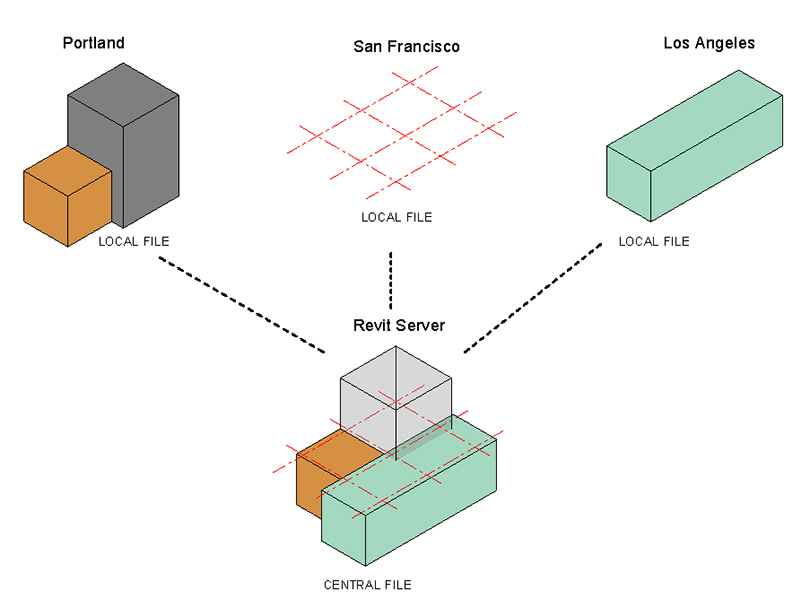As a project architect, I have been a willing and interested guinea pig...a couple of times. Most recently that came in the form of innovating an exciting new way to coordinate design documents with architectural partners and sub-consultants.

SRG has been collaborating with other architects for years using AutoCAD, a computer-aided drafting program used to produce 2D drawings. Using AutoCAD to document a project, our design team would simply divide the model into pieces according to scope of work. However, this process made for challenging coordination because no team member had access to real-time versions of each other's files. AutoCAD also does not provide for views to the 'real' building.
Revit, a Building Information Modeling (BIM) software, brought us a more holistic method to develop the project documents. By using Revit we transitioned from drawing architectural plans with lines to constructing the building electronically-by creating a digital 3D model. This integrated process brings the whole design team into a model and lets us see how everything will work together. The goal is to link all disciplines-architect, structural, MEP, etc.- and maintain a "real time" modeling process.
When the design began for a pediatric orthopedic ambulatory surgical center renovation in Los Angeles, California in partnership with CO Architects who are located in Los Angeles, we asked, "How do both firms work separately yet maintain a single model?"
SRG's Bjorn Clouten and Greg Moore worked on the idea that CO Architects could remotely access a computer of 'their own' located at SRG using a Remote Desktop Protocol (RDP) and work in the central model file located on the SRG server in order to create our first truly collaborative singular model. Bjorn asked me if I'd be willing to try using Revit in this completely new way. Seeing the potential benefit, I jumped at the chance.
It worked! By allowing CO Architects to remotely access the model hosted on SRG's server, all team members worked in one model without the need to break it into multiple pieces-we only needed to maintain rules for who worked on which portions of the building model. This method turned out quite well with little or no problems with working speed. However, there was an investment required for each firm for both hardware and extra Revit licenses.
Other projects that called for strong collaboration were the Oregon State Hospital Psychiatric Hospitals in Salem and later Junction City. The team, with Jon Mehlschau as project architect, involved SRG's largest set of BIM models that needed to be linked together, as well as a most complex breakdown of responsibilities between SRG and our partner HOK San Francisco. Using a different RDP, both SRG and HOK were able to work in the same models, which resided on HOK's servers. This worked fine until it became a cumbersome process trying to save or open the model. There could be wait times of up to 30-40 minutes or more, and if the local team members started to save they would be given priority which could require the remote team members to start the process over again. This became a very inefficient collaboration methodology.
Bjorn continued to research what other options were available. Revit Server, already part of the Revit family, came into play. Although Revit Server is intended for a single firm with multiple locations behind the same firewall, with Bjorn's leadership we pushed the envelope by creating methods to get our partner firms access into the SRG Revit Server and thus into a shared single model.
We're currently teamed with EOP Architects in Lexington, Kentucky for another pediatric orthopedic ambulatory surgical center, and on this project we were the first to push the 'designed use' of Revit Server by creating a path for our two offices to access the same model. The hardest part was getting that pathway created between the two internet service providers, but once connected this method has worked exceedingly well.
Following this success, our Pasadena project team started their use of the same process again on a different project with CO Architects, this time armed with our knowledge of how to effectively implement Revit Server.
As our comfort and working understanding of how Revit Server works grows so does our desire to do more with it or something like it. Now we want to have all the Revit models for a given project located in one place so we can work in a more 'real time' manner. Given the aforementioned successes, Bjorn and Jon have been looking into the potential to have the consultant team member models located on the SRG server. This would eliminate the need to share our models weekly (by sending out a copy of it) then having to re-link them-a process that can take anywhere from ½ hour to 1 hour every week. There are more difficulties in allowing so many accesses behind our firewall, namely server security. So the search for the right software/hardware combination continues. Ultimately, we want our design teams to be running all models real-time, eliminating the need to coordinate models weekly, or accept week old versions.
The use of Revit Server has opened up our ability to efficiently collaborate with other firms across the country. We look forward to the next step in true collaborative and real time modeling.



